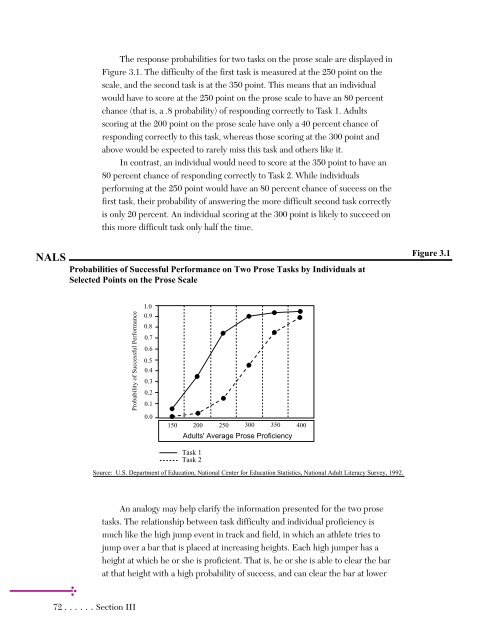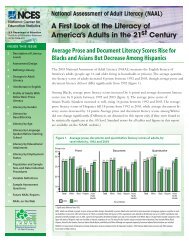Adult Literacy in America - National Center for Education Statistics ...
Adult Literacy in America - National Center for Education Statistics ...
Adult Literacy in America - National Center for Education Statistics ...
You also want an ePaper? Increase the reach of your titles
YUMPU automatically turns print PDFs into web optimized ePapers that Google loves.
NALS<br />
72 ......Section III<br />
The response probabilities <strong>for</strong> two tasks on the prose scale are displayed <strong>in</strong><br />
Figure 3.1. The difficulty of the first task is measured at the 250 po<strong>in</strong>t on the<br />
scale, and the second task is at the 350 po<strong>in</strong>t. This means that an <strong>in</strong>dividual<br />
would have to score at the 250 po<strong>in</strong>t on the prose scale to have an 80 percent<br />
chance (that is, a .8 probability) of respond<strong>in</strong>g correctly to Task 1. <strong>Adult</strong>s<br />
scor<strong>in</strong>g at the 200 po<strong>in</strong>t on the prose scale have only a 40 percent chance of<br />
respond<strong>in</strong>g correctly to this task, whereas those scor<strong>in</strong>g at the 300 po<strong>in</strong>t and<br />
above would be expected to rarely miss this task and others like it.<br />
In contrast, an <strong>in</strong>dividual would need to score at the 350 po<strong>in</strong>t to have an<br />
80 percent chance of respond<strong>in</strong>g correctly to Task 2. While <strong>in</strong>dividuals<br />
per<strong>for</strong>m<strong>in</strong>g at the 250 po<strong>in</strong>t would have an 80 percent chance of success on the<br />
first task, their probability of answer<strong>in</strong>g the more difficult second task correctly<br />
is only 20 percent. An <strong>in</strong>dividual scor<strong>in</strong>g at the 300 po<strong>in</strong>t is likely to succeed on<br />
this more difficult task only half the time.<br />
Probabilities of Successful Per<strong>for</strong>mance on Two Prose Tasks by Individuals at<br />
Selected Po<strong>in</strong>ts on the Prose Scale<br />
Probability of Successful Per<strong>for</strong>mance<br />
1.0<br />
0.9<br />
0.8<br />
0.7<br />
0.6<br />
0.5<br />
0.4<br />
0.3<br />
0.2<br />
0.1<br />
0.0<br />
150 200 250 300 350 400<br />
<strong>Adult</strong>s' Average Prose Proficiency<br />
Task 1<br />
Task 2<br />
Source: U.S. Department of <strong>Education</strong>, <strong>National</strong> <strong>Center</strong> <strong>for</strong> <strong>Education</strong> <strong>Statistics</strong>, <strong>National</strong> <strong>Adult</strong> <strong>Literacy</strong> Survey, 1992.<br />
An analogy may help clarify the <strong>in</strong><strong>for</strong>mation presented <strong>for</strong> the two prose<br />
tasks. The relationship between task difficulty and <strong>in</strong>dividual proficiency is<br />
much like the high jump event <strong>in</strong> track and field, <strong>in</strong> which an athlete tries to<br />
jump over a bar that is placed at <strong>in</strong>creas<strong>in</strong>g heights. Each high jumper has a<br />
height at which he or she is proficient. That is, he or she is able to clear the bar<br />
at that height with a high probability of success, and can clear the bar at lower<br />
Figure 3.1



